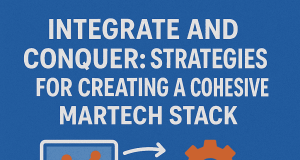In today’s digital landscape, organizations are inundated with data. From customer interactions to online behaviors, data is generated at an unprecedented scale. However, raw data is just the starting point; harnessing it effectively requires a robust Marketing Technology (Martech) strategy. A well-crafted Martech strategy transforms data into actionable insights, enabling companies to enhance customer experiences, optimize marketing efforts, and drive business growth. Here’s how to build an effective Martech strategy from the ground up.
1. Understanding Your Business Goals
Before delving into technology, it’s crucial to identify your business objectives. Are you looking to increase brand awareness, boost sales, enhance customer relationships, or improve customer retention? Clear goals will guide your Martech investments and ensure alignment between marketing operations and broader business strategies.
Key Questions to Consider:
- What are our short-term and long-term marketing goals?
- How will success be measured?
- What are the pain points in our current marketing efforts?
2. Assessing Your Current MarTech Stack
Once goals are established, take stock of your existing technology landscape. Conduct an audit of your current tools and systems, including Customer Relationship Management (CRM) software, email marketing platforms, analytics tools, and social media management applications.
Considerations in Your Audit:
- Compatibility: Do the existing tools integrate smoothly with one another?
- Performance: Are these tools delivering the insights and results you expect?
- Cost: Are you maximizing the ROI on your tech investments?
3. Identifying Data Sources
Understanding where your data comes from is key to turning it into actionable insights. Identify both internal data (sales reports, customer feedback, website analytics) and external data (market trends, social media metrics, competitor analysis).
Data Sources to Explore:
- Customer Journeys: Map out how customers interact with your brand across multiple touchpoints.
- Market Trends: Utilize third-party data to stay ahead of industry trends and shifts.
- Behavioral Insights: Use analytics to gather insights on consumer behavior and patterns.
4. Selecting the Right Tools
Choosing the right technology is critical for implementing your strategy. Look for solutions that align with your goals and seamlessly integrate with your existing stack. Key areas to focus on include:
Essential Tools:
- Analytics Platforms: For tracking website performance and customer behavior.
- CRM Systems: To manage customer relationships and streamline communication.
- Email Marketing Solutions: For managing campaigns and reaching out to clients effectively.
- Content Management Systems (CMS): To create, publish, and optimize your digital content.
5. Data Management and Governance
Investing in robust data management practices ensures the quality and integrity of your data. Establish protocols for data collection, storage, analysis, and sharing. Implement governance policies to manage who has access to sensitive data, and ensure compliance with regulations like GDPR or CCPA.
Action Steps:
- Create a centralized data repository.
- Establish standards for data collection and reporting.
- Regularly review and update data privacy policies.
6. Crafting a Customer-Centric Approach
At the heart of any successful Martech strategy is a customer-centric approach. Use data to understand your audience’s needs and preferences, allowing you to create personalized experiences.
Strategies for Personalization:
- Segmentation: Use data to segment your audience based on behavior, demographics, and preferences.
- Dynamic Content: Implement marketing automation tools that adapt content based on user interactions.
- Feedback Loops: Actively solicit customer feedback to refine your marketing strategies continuously.
7. Measuring Success and Adapting
Creating a successful Martech strategy is an ongoing process. Regularly measure the effectiveness of your strategies using key performance indicators (KPIs) aligned with your initial goals. Utilize dashboards and reporting tools to visualize progress and identify areas for improvement.
KPIs to Monitor:
- Conversion Rates: Track how many leads are turning into customers.
- Engagement Metrics: Measure interactions on digital platforms.
- Customer Lifetime Value (CLV): Understand the long-term value of acquiring customers.
Conclusion
In an era where data drives decisions, crafting a winning Martech strategy is essential for any organization. By transforming data into actionable insights, businesses can make informed decisions that enhance customer experience and drive sustainable growth. Remember, a successful strategy is adaptable; continuously assess, refine, and optimize to meet the dynamic needs of your audience and industry.
By embracing a customer-centric approach and investing in the right tools and practices, your business will be well-positioned to navigate the complexities of the digital marketing landscape and achieve lasting success.








